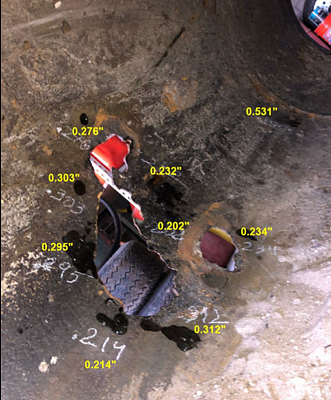Decades of pipeline corrosion and the presence of a buried log led to a June 2020 sewage spill of approximately 14.7 million gal (55,645.6 m3) in Manatee County, Florida, USA, according to a newly released investigative report by Berkeley Research Group (BRG) (Emeryville, California, USA).1
At 20 in (508 mm) in diameter, the affected iron pipe flows under the bed of Sarasota Bay, transporting sewage from the barrier-island town of Longboat Key along the Florida Gulf Coast to a wastewater treatment facility in Bradenton.
How the Break Occurred
 The report states the break took place in a buried inland section of approximately 0.5 in (12.7 mm) in thickness, and that corrosion had degraded the thickness by half. The report says the root or log likely began wearing away at the pipe shortly after its installation in 1973, but not to the point to initiate corrosion until about two decades ago. Minor repairs to various coating breaches were routinely made over the years.
The report states the break took place in a buried inland section of approximately 0.5 in (12.7 mm) in thickness, and that corrosion had degraded the thickness by half. The report says the root or log likely began wearing away at the pipe shortly after its installation in 1973, but not to the point to initiate corrosion until about two decades ago. Minor repairs to various coating breaches were routinely made over the years.
The report cites a corrosion expert as stating that 0.125 in (3.2 mm) of thickness loss would be expected if iron was exposed to seawater for nine years, which led to a calculation of 18 years. “It’s likely that it took several years for the exterior pipe coating to have abraded enough to allow corrosion to start, which puts the original damage likely starting around the time of the original installation,” the BRG report says. The rupture occurred in a section of the line where the wall had become especially thin.
Once excavation workers arrived at the scene of the spill, about 350 ft (106.7 m) from the Sarasota Bay shoreline on June 30, 2020, pumps cleared standing water from around the pipe. In turn, this allowed for a clear view of the break. “The pumps were able to expose the damaged section of pipe to the point that I observed a log or root lying perpendicular at a slight angle under the damaged section,” the report quotes an eyewitness as saying. “The log was approximately 6 to 8 in [152.4 to 203.2 mm] around and stretched beyond the width of the pipe. Water was pouring out at the approximate position of the log or root.”
Research Analysis
For years after the original construction, the log or root effectively acted “as a fulcrum under the pipe,” according to analysis from the BRG report’s authors. In turn, this likely abraded the exterior pipe coating, which led to corrosion. “Given the excessively corroded pipe wall condition at the breach location, it is likely that the pipe experienced a force, such as a surge or purge pressure, that instantly caused the weakened pipe section to break,” the report says. “In that instant, the pipe crushed down onto the log, which partially blocked the opening.” The shape of the hole in the pipe matched the nearby log’s shape, according to investigators.
Just prior to the rupture, Longboat Key officials were focused on completing a two-week-long wastewater project that involved cleaning the main line between two of the barrier island’s seven lift stations. Days later, a contractor hit a line in front of the Manatee County treatment plant. While utilities staffers began to notice significant fluctuations in meter readings, they did not locate the root of the problem for nearly two weeks. The initial repair to put the pipeline back in service and stop the leak cost more than $76,000.
Long-Term Outlook
The pipeline’s most recent inspection was completed in 2017 by engineering firm Greeley and Hansen (Chicago, Illinois, USA), who determined that it had a remaining useful lifespan of at least 20 years. While the inspection did find some localized corrosion, those inspectors concluded that “a catastrophic failure would not occur in the next 20 to 25 years.” BRG investigators, who were hired by the town to estimate the volume of the June 2020 spill, say they do not know why the earlier inspection did not detect an anomaly at the failure point.
Under a proposed consent order, the Florida Department of Environmental Protection (FDEP) (Tallahassee, Florida, USA) is seeking more than $240,000 in civil penalties for the break, though the town also has the option of pursuing an in-kind environmental enhancement project, subject to FDEP approval. In the long run, town officials say they are considering several options to construct a new sewer pipeline.
Source: Berkeley Research Group, www.thinkbrg.com.
Reference
1 “Expert Report: Calculation of Total Leaked Volume from the Town of Longboat Key Sewer Main,” Berkeley Research Group, Nov. 20, 2020, https://www.scribd.com/document/488283477/Nov-10-2020-Berkeley-Research-Group-report (Jan. 8, 2021).
Source: AMPP, www.nacecorrosion.org.